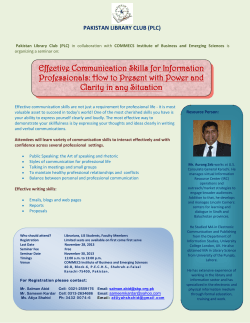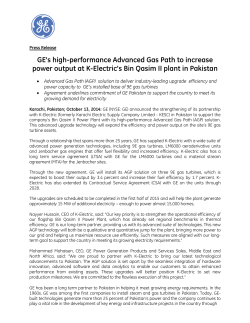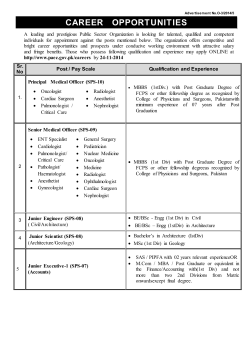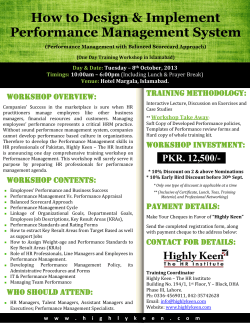
Shia Muslims, Pakistan, February 2015
Country Information and Guidance Pakistan: Shia Muslims February 2015 Preface This document provides guidance to Home Office decision makers on handling claims made by nationals/residents of – as well as country of origin information (COI) about – Pakistan. This includes whether claims are likely to justify the granting of asylum, humanitarian protection or discretionary leave and whether – in the event of a claim being refused – it is likely to be certifiable as ‘clearly unfounded’ under s94 of the Nationality, Immigration and Asylum Act 2002. Decision makers must consider claims on an individual basis, taking into account the case specific facts and all relevant evidence, including: the guidance contained with this document; the available COI; any applicable caselaw; and the Home Office casework guidance in relation to relevant policies. Country Information The COI within this document has been compiled from a wide range of external information sources (usually) published in English. Consideration has been given to the relevance, reliability, accuracy, objectivity, currency, transparency and traceability of the information and wherever possible attempts have been made to corroborate the information used across independent sources, to ensure accuracy. All sources cited have been referenced in footnotes. It has been researched and presented with reference to the Common EU [European Union] Guidelines for Processing Country of Origin Information (COI), dated April 2008, and the European Asylum Support Office’s research guidelines, Country of Origin Information report methodology, dated July 2012. Feedback Our goal is to continuously improve the guidance and information we provide. Therefore, if you would like to comment on this document, please e-mail us. Independent Advisory Group on Country Information The Independent Advisory Group on Country Information (IAGCI) was set up in March 2009 by the Independent Chief Inspector of Borders and Immigration to make recommendations to him about the content of the Home Office‘s COI material. The IAGCI welcomes feedback on the Home Office‘s COI material. Information about the IAGCI‘s work and a list of the COI documents which have been reviewed by the IAGCI can be found on the Independent Chief Inspector‘s website at http://icinspector.independent.gov.uk/country-information-reviews/ It is not the function of the IAGCI to endorse any Home Office material, procedures or policy. IAGCI may be contacted at: Independent Chief Inspector of Borders and Immigration, 5th Floor, Globe House, 89 Eccleston Square, London, SW1V 1PN. Email: chiefinspectorukba@icinspector.gsi.gov.uk Website: http://icinspector.independent.gov.uk/country-information-reviews Page 2 of 12 Contents Section 1: Guidance 4 1. Introduction 4 2. Consideration of Issues 4 3. Policy Summary 5 Section 2: Information 7 1. Overview 7 2. Blasphemy Laws 7 3. Demography 7 3.2 Representation 8 4. Violence and discrimination against Shia Muslims 8 Annex A: Caselaw 11 AW (Sufficiency of Protection) 11 Page 3 of 12 Section 1: Guidance Updated: 9 February 2015 1. Introduction 1.1 Basis of Claim 1.1.1 Fear of persecution by the Pakistani authorities or by non state actors due to the person being a Shia Muslim. Back to Contents 1.2 Summary of Issues to Consider 1.2.1 Is the person’s account a credible one? 1.2.2 Are Shia Muslims at risk of mistreatment or harm in Pakistan? 1.2.3 Are those at risk able to seek effective protection? 1.2.4 Are those at risk able to internally relocate within Pakistan? Back to Contents 2. Consideration of Issues 2.1 Is the person’s account a credible one? 2.1.1 Decision makers must consider whether the material facts relating to the person’s account of their religion and of their experiences as such are reasonably detailed, internally consistent (e.g. oral testimony, written statements) as well as being externally credible (i.e. consistent with generally known facts and the country information). Decision makers should take into account the possible underlying factors as to why a person may be inconsistent or unable to provide details of material facts. For further information on these and assessing credibility more generally, see the Asylum Instruction on Assessing Credibility and Refugee Status. Back to Contents 2.2 Are Shia Muslims at risk of mistreatment or harm, amounting to persecution, in Pakistan? 2.2.1 There are no discriminatory laws or government policies against Shias in Pakistan; neither are there any legal restrictions on freedom of religion for Shias (see ‘Overview’ in section 2 of the Country Information and Guidance on Pakistan: Ahmadis for information on religious laws). 2.2.2 There is little societal discrimination that would restrict Shias in their daily life (see Representation in the country information). 2.2.3 The greatest threat for Shias in Pakistan is sectarian violence and targeting by militants, although the intensity and frequency may vary from region to region (see Violence and discrimination against Shia Muslims in the country information). Back to Contents Page 4 of 12 2.3 Are Shia Muslims able to seek effective protection? 2.3.1 There is a general willingness by Pakistani authorities to protect Shias. During Moharram, law enforcement authorities are known to provide security for participants. Armed forces have provided security for Shia pilgrims travelling to and from Iran (see Violence and discrimination against Shia Muslims in the country information). 2.3.2 Whilst a lack of resources limits security forces ability to protect the Shia community at all times, decision makers must bear in mind that no state can provide complete protection for all of its citizens all of the time. 2.3.3 The reported case of AW (sufficiency of protection) Pakistan [2011] UKUT 31 (IAC) (26 January 2011) found that ‘Notwithstanding systemic sufficiency of state protection, a claimant may still have a well founded fear of persecution if authorities know or ought to know of circumstances particular to his/her case giving rise to the fear, but are unlikely to provide the additional protection the particular circumstances reasonably require (per Auld LJ at paragraph 55(vi)).’ 2.3.4 Therefore, decision makers must also take particular account of past persecution (if any) and consider whether there are good reasons to consider that such persecution (and past lack of sufficient protection) is likely to be repeated. For more information on the effectiveness of state protection, see also the Country Information and Guidance on Pakistan: background information, including actors of protection, and internal relocation. 2.4 Are Shia Muslims able to internally relocate within Pakistan? 2.4.1 There are a significant number of Shia communities across Pakistan. Shia mosques and places of worship are located in most major cities and towns. In most cases there are options for Shia Muslims to relocate to other areas in Pakistan (see Demography in the country information). 2.4.2 Decision makers must determine whether the person could relocate internally to a place where they would not face a real risk of serious harm and where they can reasonably be expected to stay. This assessment will need to be based on the facts of the individual case. For more general information on how to consider internal relocation, see also the relevant section of the Asylum Instruction on Assessing Credibility and Refugee Status and the Asylum Instruction on Internal Relocation. For considering internal relocation within Pakistan specifically, see also the Country Information and Guidance on Pakistan: background information, including actors of protection, and internal relocation. Back to Contents 3. Policy Summary Shia Muslims may be subject to attacks by anti-Shia and militant groups. This varies from region to region. There are many towns across Pakistan with no intercommunal sectarian tensions. Those in fear of ill-treatment by extremists will in general be able to seek effective protection from the authorities, or internally relocate within Pakistan. Where a claim falls to be refused, it is likely to be certifiable as ‘clearly unfounded’ under section 94 of the Nationality, Immigration and Asylum Act 2002. Page 5 of 12 For further information on making asylum decisions, see the Asylum Instruction on Assessing Credibility and Refugee Status, the Asylum Instruction on Humanitarian Protection and the Asylum Instruction on Discretionary Leave. For further information on certification, see the Asylum Instruction on Non-Suspensive Appeals: Certification Under Section 94 of the NIA Act 2002. Back to Contents Page 6 of 12 Section 2: Information Updated: 9 February 2015 1. Overview 1.1.1 For a general overview of religious laws, freedoms and background, see ‘Overview’ in section 2 of the Country Information and Guidance on Pakistan: Ahmadis. 2. Blasphemy Laws 2.1.1 For a summary of the blasphemy laws and the penalties for breaching them, see ‘Blasphemy Laws’ in section 2 of the Country Information and Guidance on Pakistan: Ahmadis. Back to Contents 3. Demography 3.1.1 Over 95 per cent of Pakistan’s population are Muslim1; the Shia Muslim population is estimated to be between five and 20 per cent.2 The majority of Pakistan’s Shia community adhere to the Twelver (athna ashariya) school of thought; other sub-sects, include Nizari Ismailis, Daudi Bohras and Sulemani Bohras. Nizari Ismailis are the second largest branch of Shia Islam in Pakistan after the Twelvers. 3 3.1.2 The Australian Department of Foreign Affairs and Trade (DFAT) December 2013 report, on Shias in Pakistan, stated that: ‘The Shia population is spread throughout Pakistan but there are no provinces where Shias constitute a majority. The semi-autonomous region of Gilgit–Baltistan is one of the few areas where Shias form a majority of the population. Across the country, Sunni and Shia communities are generally integrated and live side-by-side in their daily lives. Significant numbers of Shias can be found in Peshawar, Kohat, Hangu and Dera Ismail Khan in Khyber Pakhtunkhwa; Kurram and Orakzai Agencies in FATA; in and around Quetta and the Makran coastline in Balochistan; areas of southern and central Punjab; and throughout Sindh. Many urban centres in Pakistan, including Karachi, Lahore, Rawalpindi, Islamabad, Peshawar, Multan, Jhang and Sargodha, are home to large Shia communities. DFAT has observed that some Shias live in enclaves in major cities.’ 4 3.1.3 Sources reported that common Shia names include Abbas, Ali, Hasan, Hussain, Jafery, Jaffer, Naqvi, Raza, Rizvi, Sayyed and Zaidi. 5 6 1 CIA World Factbook, Pakistan, updated 27 March 2014, People and society, https://www.cia.gov/library/publications/the-world-factbook/geos/pk.html, date accessed 7 April 2014 2 Immigration and Refugee Board of Canada, Pakistan: How Shia Muslims differ from Sunnis; treatment of Shias, particularly in Lahore and Multan; government response to violence against Shia Muslims (2010-December 2013), 9 January 2014, PAK104713.E , available at: http://www.refworld.org/docid/52eba0284.html, date accessed 7 April 2014 3 Australian Government, Department of Foreign Affairs and Trade (DFAT) reports, Thematic Report: Shias in Pakistan, 18 December 2013, Page 3, https://www.immi.gov.au/media/publications/pdf/dfat-tir-pakistan.pdf, date accessed 9 April 2014 4 Australian Government, Department of Foreign Affairs and Trade (DFAT) reports, Thematic Report: Shias in Pakistan, 18 December 2013, Page 5, https://www.immi.gov.au/media/publications/pdf/dfat-tir-pakistan.pdf, date accessed 9 April 2014 5 Australian Government, Department of Foreign Affairs and Trade (DFAT) reports, Thematic Report: Shias in Pakistan, 18 December 2013, Page 6, https://www.immi.gov.au/media/publications/pdf/dfat-tir-pakistan.pdf, date accessed 9 April 2014 6 Immigration and Refugee Board of Canada, Pakistan: How Shia Muslims differ from Sunnis; treatment of Shias, particularly in Lahore and Multan; government response to violence against Shia Muslims (2010-December 2013), 9 January 2014, PAK104713.E , available at: http://www.refworld.org/docid/52eba0284.html, date accessed 7 April 2014 Page 7 of 12 3.1.4 Apart from Hazaras, Shias are not physically, linguistically or legally distinguishable from Sunni Pakistanis. Computerised national identity cards do not identify the card holder’s sect. 7 3.1.5 The BBC and Immigration and Refugee Board of Canada described the differences between Sunni and Shia Muslims. 3.2 Representation 3.2.1 The Australian Department of Foreign Affairs and Trade (DFAT) December 2013 report, on Shias in Pakistan, stated that: ‘Shias are represented across most of Pakistan’s ethnic, linguistic and tribal groups. However, Hazaras are a predominantly Shia ethnic community and there are a range of other Shia communities that have tribal/ethnic identities such as the Turis, Bohris, Baltis and some clans within the Bangash Pashtun tribes... Shia mosques and sites of worship (imambargahs) are located across Pakistan, including in most major cities and towns. Shias can (although rarely do) pray in Sunni mosques and vice versa. There are also a number of famous religious sites that are attended by both sects. Many of these are Sufi shrines.’ 8 3.2.2 DFAT further noted that ‘Shias in Pakistan are often employed in Government and hold high offices. Notable examples include former Presidents and Prime Ministers. Shias are well represented in Parliament, the police, judiciary and other institutions. Shias are represented on Pakistan’s Council of Islamic Ideology, the Constitutional body that provides advice to the Government of Pakistan on issues of Islamic jurisprudence and practice. Shias also have representation in the Shariat Courts.’ 9 Back to Contents 4. Violence and discrimination against Shia Muslims 4.1.1 For further information on violence in Pakistan, see also the ‘Sectarian violence’ in section 2 of the Country Information and Guidance on Pakistan: Fear of Taliban and other militant groups. 4.1.2 In 2013, the South Asia Terrorism Portal (SATP) recorded more Shia deaths in Pakistan than since their records began in 2001. The SATP listed 81 incidents in which 504 people died, and 965 were injured.10 Types of violence included sectarian clashes, militant attacks and targeted assassinations.11 The SATP recorded attacks against Shias resulting in death or injury from 2001 to the present in its database of Shias killed in Pakistan since 2001, last updated 1 February 2015.12 7 Australian Government, Department of Foreign Affairs and Trade (DFAT) reports, Thematic Report: Shias in Pakistan, 18 December 2013, Page 6, https://www.immi.gov.au/media/publications/pdf/dfat-tir-pakistan.pdf, date accessed 9 April 2014 8 Australian Government, Department of Foreign Affairs and Trade (DFAT) reports, Thematic Report: Shias in Pakistan, 18 December 2013, Page 5 and 6, https://www.immi.gov.au/media/publications/pdf/dfat-tir-pakistan.pdf, date accessed 9 April 2014 9 Australian Government, Department of Foreign Affairs and Trade (DFAT) reports, Thematic Report: Shias in Pakistan, 18 December 2013, Page 6, https://www.immi.gov.au/media/publications/pdf/dfat-tir-pakistan.pdf, date accessed 9 April 2014 10 South Asia Terrorism Portal, Shias killed in Pakistan since 2001, http://www.satp.org/satporgtp/countries/pakistan/database/Shias_killed_Pakistan.htm, date accessed 7 April 2014 11 Australian Government, Department of Foreign Affairs and Trade (DFAT) reports, Thematic Report: Shias in Pakistan, 18 December 2013, Page 6, https://www.immi.gov.au/media/publications/pdf/dfat-tir-pakistan.pdf, date accessed 9 April 2014 12 South Asia Terrorism Portal, Shias killed in Pakistan since 2001, http://www.satp.org/satporgtp/countries/pakistan/database/Shias_killed_Pakistan.htm, date accessed 9 February 2015 Page 8 of 12 4.1.3 Prominent anti-Shia groups, which are banned by the Pakistani government, include the Lashkar-e-Jhangvi (LeJ), the Ahl-e-Sunnat Wal Jama’at (ASWJ), previously known as Sipah-e-Sahaba Pakistan (SSP), and the Tehrik-e-Taliban Pakistan (TTP).13 The LeJ is reported to have historical links to the Pakistani military and intelligence agencies although the military denies any ongoing links. 14 4.1.4 Human Rights Watch reported in its World Report 2014, which recorded 2013 events, that: ‘In Balochistan province, at least 200 Shias, mostly from the Hazara community, were killed in and around the provincial capital, Quetta. In January, a suicide bomb killed 96 Hazaras and injured at least 150. In February, at least 84 were killed and over 160 injured when a bomb exploded in a vegetable market in Quetta’s Hazara town. The LEJ claimed responsibility for both attacks. In March, at least 47 Shias were killed and 135 injured in the port city of Karachi when a Shia-majority neighborhood was targeted in a bomb attack. Some 50 apartments and 10 shops were destroyed. Throughout the year, dozens of other Shia across Pakistan were targeted and killed.’ 15 4.1.5 The US Commission on International Religious Freedom Annual Report 2013 reported grossly inadequate state protection for Shia Muslims and that ‘the government has proven unwilling or unable to crack down on groups that repeatedly plan, conduct, and claim credit for attacks, or prevent future violence.’ 16 However, some media sources reported police protection during times of sectarian tension. 17 4.1.6 Attacks against Shias escalate during the Muslim holy month of Moharram, particularly on Shia processions marking Ashura, the 10th day of Moharram. In 2012 the TTP claimed responsibility for a number of attacks during Moharram that killed more than 30 Shias and wounded around 200. 18 At least eight people were killed and 30 injured when a Shia procession was attacked in Rawalpindi on 15 November 2013. 19 Aside from the incident in Rawalpindi, Ashura passed peacefully in most of the country on account of the security measures put in place by Pakistan’s law enforcement authorities. Several suspected militants were arrested in Karachi, and security cameras helped prevent terrorist activity in Lahore. 20 4.1.7 According to sources, attacks against Shia Muslims occur in all regions across Pakistan but are particularly prominent in Quetta, Balochistan. Other areas with notable levels of violence include Karachi, Gilgit Baltistan, and some cities in Pakistan’s north west tribal 13 South Asia Terrorism Portal, South Asia Intelligence Review, Weekly Assessments & Briefings, Volume 12, No. 4, July 29, 2013, Pakistan – Shia: Sectarian targets, http://www.satp.org/satporgtp/sair/Archives/sair12/12_4.htm#assessment2, date accessed 10 April 2014 14 Human Rights Watch, Pakistan: Deter Escalating Attacks on Shia Muslims, 12 November 2013, http://www.hrw.org/news/2013/11/11/pakistan-deter-escalating-attacks-shia-muslims, date accessed 14 April 2014 15 Human Rights Watch, World Report 2014 – Pakistan, 21 January 2014, Sectarian attacks, http://www.hrw.org/world-report/2014/country-chapters/pakistan, date accessed 7 April 2014 16 US Commission on International Religious Freedom http://www.uscirf.gov/, Annual Report 2013, April 2013, page 125, http://www.uscirf.gov/sites/default/files/resources/Pakistan%202013%281%29.pdf, date accessed 27 January 2014 17 Immigration and Refugee Board of Canada, Pakistan: How Shia Muslims differ from Sunnis; treatment of Shias, particularly in Lahore and Multan; government response to violence against Shia Muslims (2010-December 2013), 9 January 2014, PAK104713.E , available at: http://www.refworld.org/docid/52eba0284.html, date accessed 7 April 2014 18 Human Rights Watch, Pakistan: Deter Escalating Attacks on Shia Muslims, 12 November 2013, http://www.hrw.org/news/2013/11/11/pakistan-deter-escalating-attacks-shia-muslims, date accessed 14 April 2014 19 Al Jazeera, Deadly attack on Shia procession in Pakistan, 16 November 2013, http://www.aljazeera.com/news/asia/2013/11/deadly-attack-shia-procession-pakistan-2013111602136312926.html, date accessed 14 April 2014 20 The Express Tribune, Rawalpindi tragedy mars otherwise peaceful Ashura, 15 November 2013, http://tribune.com.pk/story/632311/muharram-10-live-updates-2/, date accessed 15 April 2014 Page 9 of 12 areas. 21 Shia pilgrimage routes between Pakistan and Iran, travelling through Balochistan, were subject to attack. In January 2014, Dawn reported that, following a suicide bomb attack against Hazara Shia pilgrims travelling to Iran, security forces escorted the pilgrims’ coaches on their return journey. 22 When the road between Quetta and the Iranian border was closed due to the attack, the Pakistan Air Force airlifted 215 pilgrims back to Quetta. 23 Back to Contents 21 Immigration and Refugee Board of Canada, Pakistan: How Shia Muslims differ from Sunnis; treatment of Shias, particularly in Lahore and Multan; government response to violence against Shia Muslims (2010-December 2013), 9 January 2014, PAK104713.E , available at: http://www.refworld.org/docid/52eba0284.html, date accessed 7 April 2014 22 Dawn, Pakistan's Shia pilgrimage route to Iran suspended, 25 January 2014, http://www.dawn.com/news/1082419/pakistans-shia-pilgrimage-route-to-iran-suspended, date accessed 14 April 2014 23 FCO, Pakistan - country of Concern: latest update, 31 March 2013, published 10 April 2014, https://www.gov.uk/government/publications/pakistan-country-of-concern/pakistan-country-of-concern-latestupdate-31-march-2013, date accessed 14 April 2014 Page 10 of 12 Annex A: Caselaw AW (Sufficiency of Protection) AW (sufficiency of protection) Pakistan [2011] UKUT 31(IAC) (26 January 2011) The Upper Tribunal of the Immigration and Asylum Chamber found that: 1. At paragraph 55 of Auld LJ’s summary in Bagdanavicius [2005] EWCA Civ.1605 it is made clear that the test set out in Horvath [2001] 1 AC 489 was intended to deal with the ability of a state to afford protection to the generality of its citizens. 2. Notwithstanding systemic sufficiency of state protection, a claimant may still have a well founded fear of persecution if authorities know or ought to know of circumstances particular to his/her case giving rise to the fear, but are unlikely to provide the additional protection the particular circumstances reasonably require (per Auld LJ at paragraph 55(vi)). 3. In considering whether an appellant’s particular circumstances give rise to a need for additional protection, particular account must be taken of past persecution (if any) so as to ensure the question posed is whether there are good reasons to consider that such persecution (and past lack of sufficient protection) will not be repeated. Back to Contents Page 11 of 12 Change Record Version Date Change References 1.0 16/07/2014 First version of CIG on Religious freedom 2.0 January 2015 Updated COI sections; guidance separated from wider ‘religious freedom’ CIG. Back to Contents Page 12 of 12
© Copyright 2025









